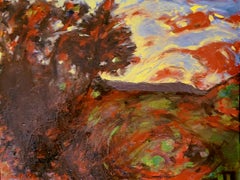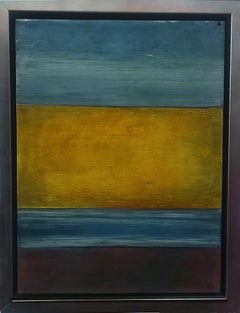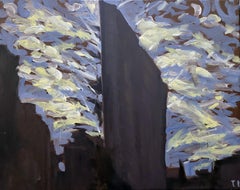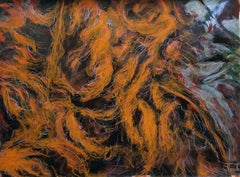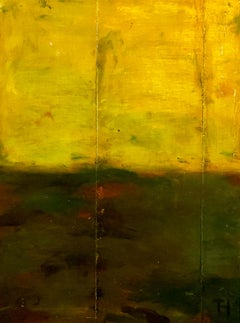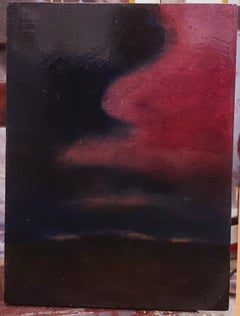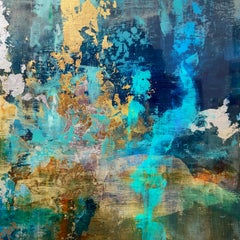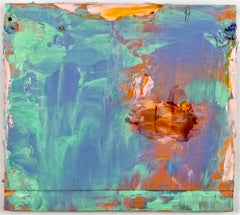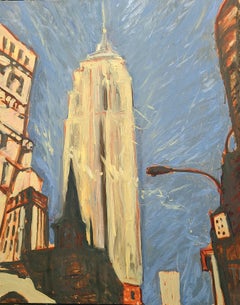Tom Irizarry Studio Abstract Paintings
American, b. 1958
The studio is my laboratory, and a Magical place.
The possibility of creating a work of art that resonates so deeply, it cannot be unseen or unheard, drives me.
Creative forces enable me to observe and infuse New York and Chicago urbanscapes with bold energy and deep feeling,
I put a body on an invisible entity. Yes, they are representational, however, the pictorial effect forms a communication to the viewer.
Some might call it alchemy, that finds its way in my paintings as a strong unavoidable vibration from my own hand and the materials I use.
Tom Irizarry is a man who does not compromise in any avenue of life and especially in making paintings.
My work, like myself, stands firm on it's own ground. If you can see a fraction of what goes through my imagination as I am painting, well then my job is complete.to
3
4
1
1
1
Overall Width
to
Overall Height
to
7
3
1
5
2
2
2
2
7
7
6
4
4
25
664
620
458
342
2
7
Artist: Tom Irizarry Studio
Fort Greene Park
By Tom Irizarry Studio
Located in Booklyn, NY
In 1981, Fort Greene Park was somewhat neglected and bared the same existential, graffitied, stamp mark that covered most of NYC in the 80's. Fort Greene Park became part of my hist...
Category
2010s Modern Tom Irizarry Studio Abstract Paintings
Materials
Resin, Oil, Wood Panel, Pigment
Votive, color field, oil on panel, 2020
By Tom Irizarry Studio
Located in Booklyn, NY
“… look into the stains of walls, or the ashes of a fire, or clouds, or mud … you may find really marvelous ideas. The mind of the painter is stimulated to new discoveries … various ...
Category
2010s Color-Field Tom Irizarry Studio Abstract Paintings
Materials
Underglaze, Oil, Wood Panel
$2,655 Sale Price
55% Off
Flat Iron Building, New York City
By Tom Irizarry Studio
Located in Booklyn, NY
I often cross Manhattan on the way to appointments. Though I
have done this many times over the years, one clear blue day, the brightness of the clouds caught my attention.
Looming over 5th Avenue in Manhattan, NYC, The Flat Iron Building...
Category
2010s Modern Tom Irizarry Studio Abstract Paintings
Materials
Resin, Oil, Wood Panel, Pigment
The Stirring
By Tom Irizarry Studio
Located in Booklyn, NY
Sometimes, while walking, a cluster of color catches my eye on the street. It was a warm Fall that year, and I was shocked how rich and deep, the color of the dead leaves were on the...
Category
2010s American Impressionist Tom Irizarry Studio Abstract Paintings
Materials
Oil, Archival Paper, Pigment
$1,200 Sale Price
52% Off
Relic of a Sunken Day Brooklyn
By Tom Irizarry Studio
Located in Booklyn, NY
Painted on panel, this piece dates back to the 1990's when I created a collection of small panel paintings. Relic of a Sunken Day shows layers of oil glazes on aluminum on panel crea...
Category
2010s Tom Irizarry Studio Abstract Paintings
Materials
Resin, Oil, Wood Panel, Pigment
Brooklyn Dusk Panel Painting
By Tom Irizarry Studio
Located in Booklyn, NY
Brooklyn Dusk is painted on panel. The glass-like finish can be achieved on few other surfaces. I was attracted to this style of painting early on, seduced by the deep delicate tones...
Category
2010s Modern Tom Irizarry Studio Abstract Paintings
Materials
Canvas, Resin, Oil, Pigment
$2,000 Sale Price
20% Off
The Battle, Luminism, oil, pigment on archival paper
By Tom Irizarry Studio
Located in Booklyn, NY
It is only after we emerged from the horrible Pandemic, that we realized what a battle it was for simple daily living. Tom created The Battle a few years into the Pandemic.
The pict...
Category
2010s Naturalistic Tom Irizarry Studio Abstract Paintings
Materials
Oil, Rag Paper, Pigment
Related Items
"Brian O'Neill's 'Deep Dive 1' Original Acrylic Painting with 24K Gold Leaf"
Located in Denver, CO
Brian O'Neill's "Deep Dive 1" is an extraordinary original artwork created in 2024. This piece measures 12 x 12 x 1.50 inches (30.48 x 30.48 x 3.81 cm) and showcases a masterful blen...
Category
2010s Abstract Impressionist Tom Irizarry Studio Abstract Paintings
Materials
Gold Leaf
Modernist Gestural Abstract Color Field Painting Woman Artist Francine Tint
By Francine Tint
Located in Surfside, FL
Francine Tint (b. 1943)
Another Time
Thick acrylic impasto on board, 1999,
Hand signed 'Francine Tint' titled, dated
Inscribed 'To Piri, Enjoy Much Love' on the reverse.
14 x 15 1/...
Category
1990s Color-Field Tom Irizarry Studio Abstract Paintings
Materials
Acrylic, Acrylic Polymer, Wood Panel
WPA Impressionist Figurative Landscape Oil Painting Panel "Ocho Rios" Jamaica
Located in Portland, OR
A important American Impressionist painting by Isabella Howland (1895-1974), "Ocho Rios", Jamaica, 1940.
Howland was active in both Boston & New York, this impressionistic painting d...
Category
1940s American Impressionist Tom Irizarry Studio Abstract Paintings
Materials
Oil
$3,295
H 15.5 in W 20.25 in D 1.5 in
FARAWAY LAND
By Arturo Mallmann
Located in Three Oaks, MI
Arturo Mallmann’s abstract landscapes radiate a shiny gloss that makes them appear as glass canvases, but they are not in fact glass. Mallmann’s process includes a complicated approa...
Category
2010s Contemporary Tom Irizarry Studio Abstract Paintings
Materials
Epoxy Resin, Acrylic, Wood Panel
Abstract Painting Blue Sea I Pigments Contemporary Artist Gabriela Meunie
Located in Barcelona, Barcelona
At Escat Gallery we are committed to maintaining the highest standards of trust and professionalism for our collectors. Every artwork in our collection comes with a Certificate of Au...
Category
2010s Abstract Tom Irizarry Studio Abstract Paintings
Materials
Resin, Cotton Canvas, Pigment
$2,384
H 31.5 in W 31.5 in D 1.58 in
Pink Geometric Altar Diptych, Surreal Landscape, Modern Monument Architecture
By Natalia Roman
Located in Barcelona, ES
These series of paintings by Natalia Roman gather their inspiration from geometric, minimalist shapes and paintings from the beginning of Modernism, with a special emphasis on Art De...
Category
2010s Color-Field Tom Irizarry Studio Abstract Paintings
Materials
Acrylic, Handmade Paper
Bella Vista 3 - Modern Acrylic Colorful Striped Resin Artwork
By Ricky Hunt
Located in Los Angeles, CA
Ricky Hunt’s mixed media minimalist wall art is influenced by his tumultuous past that led to a paradigm shift in creativity and life. He covers the wood panel with layers of acrylic...
Category
21st Century and Contemporary Minimalist Tom Irizarry Studio Abstract Paintings
Materials
Resin, Mixed Media, Acrylic, Wood Panel
"White Landscape" Abstract landscape Painting , Original art Made in Italy
By Marilina Marchica
Located in Agrigento, AG
White Landscape
oil on canvas 60x81cm
2025
original art
Ready to hang
certificate of authenticity included
Marilina Marchica was born in Agrigento, where she works and lives,
Afte...
Category
2010s Contemporary Tom Irizarry Studio Abstract Paintings
Materials
Canvas, Oil, Pigment
$1,605 Sale Price
20% Off
H 31.89 in W 23.63 in D 0.79 in
Christian Gardair Monumental Painting "Oceano Graphie", 1983
Located in Washington, DC
Exceptional and large painting by French artist Christian Gardair (French, b.1938). Painting is acrylic on polyester paper. Signed and titled "Oceano Graphie" dated 1983. Painting me...
Category
1980s Color-Field Tom Irizarry Studio Abstract Paintings
Materials
Acrylic, Synthetic Paper
$7,250 Sale Price
50% Off
H 85 in W 127 in
Contemporary Abstract Colorfield Landscape in Cream & Green
By Michael Pauker
Located in Soquel, CA
A striking contemporary two-toned colorfield abstract by Bay Area artist Michael Pauker (American, b. 1957). A large neutral textured section in cream sits atop a wavy abstraction in...
Category
21st Century and Contemporary Color-Field Tom Irizarry Studio Abstract Paintings
Materials
Oil, Canvas
$3,150
H 40 in W 30 in D 1 in
White Sand Beach #32
Located in Denver, CO
Ana Hefco's "White Sand Beach #32" is an original, hand made resin painting that depicts an abstracted color field of blue, teal and beige, that is reminiscent of an aerial/satellite...
Category
21st Century and Contemporary Tom Irizarry Studio Abstract Paintings
Materials
Resin, Wood Panel
Mountain Series, Orange Light
By Ira Barkoff
Located in Greenwich, CT
Born in 1934 in Brooklyn, New York, Ira Barkoff’s paintings feature empty, Zen-like landscapes whose stillness reflects a location’s essence. Barkoff seeks to “portray a sense of vas...
Category
2010s Color-Field Tom Irizarry Studio Abstract Paintings
Materials
Canvas, Oil
Previously Available Items
The Empire State Building
By Tom Irizarry Studio
Located in Booklyn, NY
I was fortunate enough to care give for my father in the final years of his life. I came to know a New York City that my father grew up in during the 1930's. He was nine years old. H...
Category
2010s Modern Tom Irizarry Studio Abstract Paintings
Materials
Canvas, Resin, Oil, Pigment
Tom Irizarry Studio abstract paintings for sale on 1stDibs.
Find a wide variety of authentic Tom Irizarry Studio abstract paintings available for sale on 1stDibs. You can also browse by medium to find art by Tom Irizarry Studio in oil paint, paint, glaze and more. Much of the original work by this artist or collective was created during the 21st century and contemporary and is mostly associated with the modern style. Not every interior allows for large Tom Irizarry Studio abstract paintings, so small editions measuring 11 inches across are available. Tom Irizarry Studio abstract paintings prices can differ depending upon medium, time period and other attributes. On 1stDibs, the price for these items starts at $4,485 and tops out at $5,900, while the average work can sell for $5,193.
